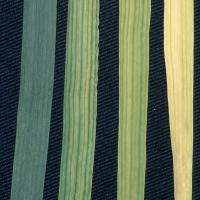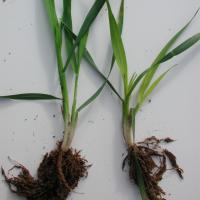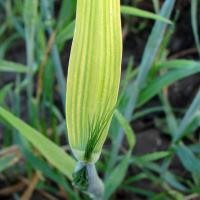Diagnosing iron deficiency in cereals
Iron deficiency is rare but can be a problem in high-rainfall areas on peaty or calcareous soils, or after heavy lime application on most soils.
What to look for
- Pale plants particularly in waterlogged or limed areas.
Paddock
- Youngest growth is affected first and most severely.
- Symptoms begin with young leaves turning pale green or yellow.
- Inter-veinal areas become yellow and in severely deficient plants the inter-veinal area turns almost white.
- New growth remains yellow for some time before leaves start to die.
- Old leaves remain pale green and apparently healthy.
- Severely affected plants are stunted with thin spindly stems.
Plant
What else could it be
| Condition | Similarities | Differences |
|---|---|---|
| Diagnosing sulphur deficiency in cereals | Pale plants with pale new growth | Sulphur deficient plants do not have interveinal chlorosis |
| Diagnosing group B herbicide damage in cereals | Pale seedlings with interveinal chlorosis on new leaves | Herbicide damaged plants generally recover and are not restricted to waterlogged areas |
|
Waterlogging, nitrogen, molybdenum and manganese deficiency
|
Pale growth | However middle or older leaves are affected first |
Where does it occur?

Wet conditions
- Iron deficiency can occur in highly calcareous or limed soils, particularly in cold and wet conditions.
- Symptoms on heavily limed paddocks are transient and restricted to the season in which the lime has been applied.
Management strategies

Spraying foliar
- No yield responses to iron to justify soil application.
- Where symptoms occur, particularly in cold and wet conditions, they are frequently eliminated by increased soil and air temperatures.
- Foliar sprays will remove the symptoms where they occur in highly calcareous or limed soils.
How can it be monitored?

Tissue test
- Use whole-tops for plant testing and compare iron level between affected and unaffected plants.
- The critical concentration for youngest emerged blade and whole shoot hasn't been determined for Australian grown cereals. However greater than 50 milligrams per kilogram (mg/kg) at the boot stage appears to be adequate for growth.
See also
Further information
Where to go for expert help
Page last updated: Wednesday, 6 May 2015 - 3:16pm





